Halfway through New York Fashion Week, the buzz is that next season will offer clothes that are wearable, fairly modest and simple -- except for the occasional metallic outfit.
There have been a lot of daytime suits and shirtdresses for both working women and the ladies who lunch, and sweater coats to wear over them. Black and other dark autumnal colors dominate the palette.
However, no single look or designer has taken off as the must-have for fall.
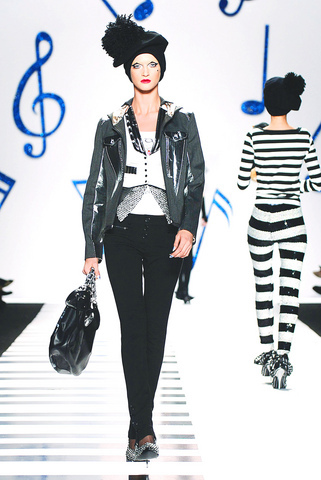
PHOTOS: AP
Monique Lhuillier: Lhuillier's days as a bridal gown designer pay off whenever she goes near lace and tulle, and the red-carpet gowns she previewed Tuesday morning were delicate, feminine and pretty. She alternated shapes between slim seamed sheaths and tufted ballgowns.
But the starlets who wear these dresses need to ward off fall's chill, and Lhuillier offered them fur capelets, brocade coats and, for the daytime, a salt-and-pepper brocade peacoat.
Marc Jacobs: There was no marching band this time, but Marc Jacobs' show was a crowd-pleaser nonetheless with a fall collection that was more Edie Sedgwick than Grace Kelly.
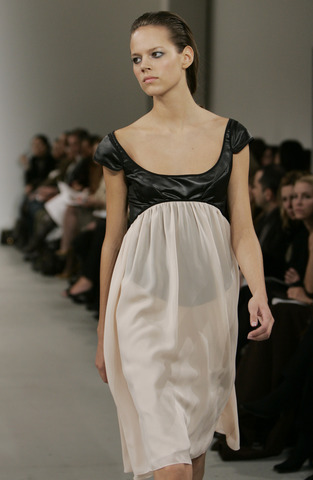
PHOTO: AP
The Penn State Blue Band kicked off Jacobs' show last season at the New York State Armory, but the theatrics this time were limited to the clothes.
Jacobs cleverly took some ladylike standbys of his past few seasons and turned them into tough-girl accessories. Dainty tea party gloves became leather, elbow-length gloves, mary janes got a patent-leather makeover and their heels were raised to dizzying heights.
Traditional fall colors and cozy fabrics were punctuated by shimmer and shine. Huge sequin berets and metallic leather boots added bombastic accents to slouchy pants layered with dresses, tiny tank tops and oversize, boxy coats.
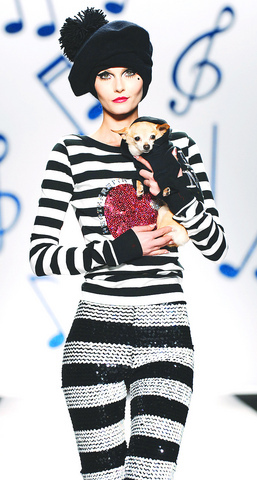
Jacobs clearly had his younger fans in mind -- Nicole Richie and Rachel Bilson cheered him on Monday night along with longtime muse Winona Ryder -- when he designed these looks, whose mix-and-match sensibility give the wearer a chance to reveal her personality instead of her body.
Max Azria Collection: This line, formerly known as BCBG Max Azria, is undergoing a transformation as the company tries to elevate the image of the runway clothes beyond cute, breezy dresses and flattering pants.
Azria concentrated on knits -- which made great casual cashmere coats and borderline bizarre bloomers. He wasn't the only designer to send bloomers down the runway. In fact, the crowd at the Bryant Park tents probably have seen more bloomers and knickers over the first four days of Fashion Week than they've seen in the last four years.
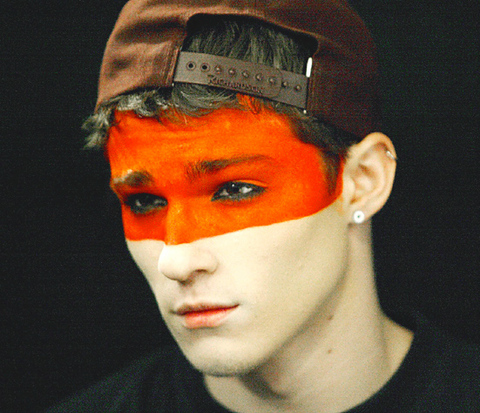
PHOTO: AP
Azria also offered several pieces that had origami details, which were similar enough to hit on the big-bow trend but different enough to stand out. But there's something to be said for simplicity, and the cashmere turtleneck dresses worn with either tweed or cashmere coats were the most sophisticated outfits in the collection.
Betsey Johnson: The sometimes risque, but always playful Johnson was on her best behavior with this collection. She offered cute cocktail dresses that surely will be on the high school dance circuit, skirt suits with miniskirts, of course and a taffeta trench coat that could go just about anywhere and be worn by just about any woman.
The trench coat, paired with a gold blouse with ruffles around the neck and a black flounce skirt, was one of the show's best outfits. A latte-colored crocheted dress and a boucle suit with candy-colored dots to break up the black background were also standouts.
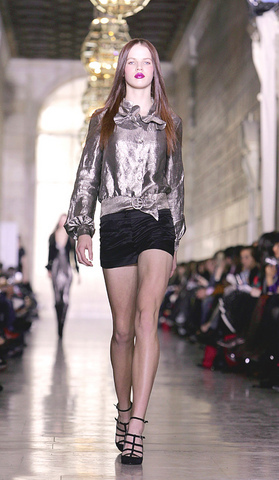
PHOTO: AFP
The hot pants and bloomers that have been far too prevalent at Fashion Week were also on Johnson's runway, but since she's Betsey Johnson, they belonged.
Jill Stuart: Stuart dresses a young crowd, and the Goth look she offered should be right up their alley. Models wore long, black Matrixlike dresses, the best being a satin version with a V neck and high waist.
The runway wasn't all somber, though. A winter white nubby coat and a silver lame all-over pleated gown were winners. Stuart then switched modes and sent out a delicate chiffon dress with flutter sleeves in an abstract blue floral print.
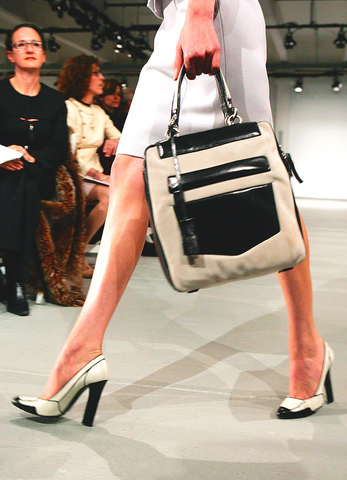
PHOTO: AP
Oscar de la Renta: De la Renta's fall collection confirms some of the emerging trends. His runway had metallic fabrics, three-quarter sleeve tops and jackets worn with long gloves, belted jackets, sweater coats and both skinny cigarette pants and wide-leg cuffed ones. Somehow, though, everything looks a little different when done by de la Renta. They're classier and more luxurious.
De la Renta traditionally does great coats and embroideries. This time he combined those skills into an outstanding brown embroidered cashmere coat with pony skin that was paired with a green leather embroidered skirt.
But de la Renta's other specialty is eveningwear, and while a black sheer tulle dress with embroidered polka dots was pretty, most of his gowns and cocktail dresses with defined waists and voluminous skirts looked stiff and of another time and place. A better black-tie look was a black cashmere jacket with embroidered rosettes, a black sequined T-shirt and skinny black flannel pants.
Carolina Herrera: Herrera said she was inspired by the late 1950s, but many of the outfits were reminiscent of the sportswear of the 1970s, when American ready-to-wear first put its stamp on the world.
She sent several suits down the runway. The skirt suits, in a rust plaid, were fitted and to the knee; the pants had wide cuffed legs.
A new look for fall is fur sheared so close it looks like soft velvet. Herrera used that technique for the sleeves on a black and brown wool dress that was otherwise simple -- and very sophisticated.
Herrera matched coats with cocktail dresses to create a complete outfit, and the chocolate broadtail coat with a turquoise swirl print lining with a pleated strapless dress in the same fabric was a standout.

Aug. 4 to Aug. 10 When Coca-Cola finally pushed its way into Taiwan’s market in 1968, it allegedly vowed to wipe out its major domestic rival Hey Song within five years. But Hey Song, which began as a manual operation in a family cow shed in 1925, had proven its resilience, surviving numerous setbacks — including the loss of autonomy and nearly all its assets due to the Japanese colonial government’s wartime economic policy. By the 1960s, Hey Song had risen to the top of Taiwan’s beverage industry. This success was driven not only by president Chang Wen-chi’s

Last week, on the heels of the recall election that turned out so badly for Taiwan, came the news that US President Donald Trump had blocked the transit of President William Lai (賴清德) through the US on his way to Latin America. A few days later the international media reported that in June a scheduled visit by Minister of National Defense Wellington Koo (顧立雄) for high level meetings was canceled by the US after China’s President Xi Jinping (習近平) asked Trump to curb US engagement with Taiwan during a June phone call. The cancellation of Lai’s transit was a gaudy

From Godzilla’s fiery atomic breath to post-apocalyptic anime and harrowing depictions of radiation sickness, the influence of the nuclear bombings of Hiroshima and Nagasaki runs deep in Japanese popular culture. In the 80 years since the World War II attacks, stories of destruction and mutation have been fused with fears around natural disasters and, more recently, the Fukushima crisis. Classic manga and anime series Astro Boy is called “Mighty Atom” in Japanese, while city-leveling explosions loom large in other titles such as Akira, Neon Genesis Evangelion and Attack on Titan. “Living through tremendous pain” and overcoming trauma is a recurrent theme in Japan’s

As last month dawned, the Democratic Progressive Party (DPP) was in a good position. The recall campaigns had strong momentum, polling showed many Chinese Nationalist Party (KMT) lawmakers at risk of recall and even the KMT was bracing for losing seats while facing a tsunami of voter fraud investigations. Polling pointed to some of the recalls being a lock for victory. Though in most districts the majority was against recalling their lawmaker, among voters “definitely” planning to vote, there were double-digit margins in favor of recall in at least five districts, with three districts near or above 20 percent in